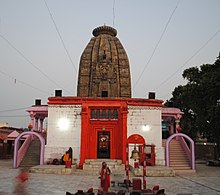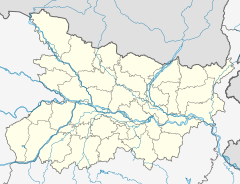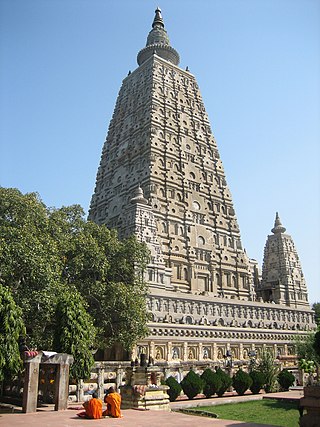
The Mahabodhi Temple or the Mahābodhi Mahāvihāra, a UNESCO World Heritage Site, is an ancient, but restored Buddhist temple in Bodh Gaya, Bihar, India, marking the location where the Buddha is said to have attained enlightenment. Bodh Gaya is 15 km from Gaya and is about 96 km (60 mi) from Patna. The site contains a descendant of the Bodhi Tree under which the Buddha gained enlightenment and has been a major pilgrimage destination of Buddhists for over two thousand years.

Chhath is an ancient Hindu festival, native to eastern India and southern Nepal. It is celebrated especially in the Indian states of Bihar, Jharkhand, and Eastern Uttar Pradesh; and the Nepalese Autonomous provinces of Koshi, Lumbini, and Madhesh. In major Indian and Nepalese urban centres like Delhi, Mumbai, Kolkata, Hyderabad, Chennai, Kathmandu, etc., the diaspora actively participates in celebrating Chhath, preserving their cultural heritage. The festival is also celebrated in countries like the USA, Australia, Singapore, UAE, Canada, Mauritius, Japan, UK, etc., by the diaspora.
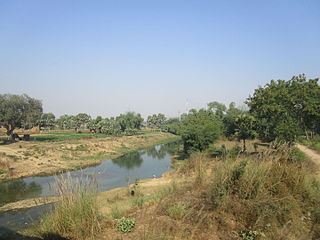
Aurangabad district is one of the thirty-eight districts of Bihar state, India. It is currently a part of the Red Corridor.
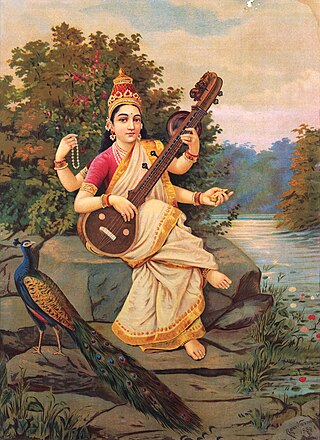
Vasant Panchami, also rendered Vasanta Panchami and Saraswati Puja in honour of the Hindu goddess Saraswati, is a festival that marks the preparation for the arrival of spring. The festival is celebrated in Indian religions in different ways depending on the region. Vasant Panchami also marks the start of preparation for Holika and Holi, which take place forty days later. The Vasant Utsava (festival) on Panchami is celebrated forty days before spring, because any season's transition period is 40 days, and after that, the season comes into full bloom.
Konch is a community development block of Gaya district in Bihar, India. Konch(Konch Village/Konch Panchayat/Konch Thana-Police Station) is a typical village market area slowly taking shape of a sub-urban settlement and centre of small business. Konch has very important temple known as Koncheswar Mahadev belonging to the later Gupta period which now has been taken under the protection of Archaeological Survey of India (ASI).
Khatangi is a prominent village in Bihar, India, situated in the Sonbhadra-Bansi-Surajpur block of Arwal district. It is located 96.1 km from Arwal and 114 km from the state capital, Patna. The village is quite old and has a population of about 5,000 people. The literacy rate is 45.56%, with a female literacy rate of 27.3% and a male literacy rate of 62.98%. The people are known for being friendly and hospitable. The economy is primarily agro-based, with agriculture being the main source of income.
Banjari is a small town at the south-western tip of Bihar state, India. It is located on the Sone River, the largest of the Ganges' southern tributaries, in Rohtas district. It is framed by the Kaimur mountain range, to the south-east of Sasaram.

The state of Bihar in eastern India, is one of the oldest inhabited places in the world with a history going back 3000 years. The rich culture and heritage of Bihar is evident from the innumerable ancient monuments that are dotted all over the state. Bihar is home to many tourist attractions and is visited by large numbers of tourists from all over the world. Around total 6 million tourists visit Bihar every year.
Bihari culture refers to the culture of the Indian state of Bihar. Bihari culture includes Angika culture, Mithila culture, Bhojpuri Culture and the culture of Magadha.

Surya is the Sun as well as the solar deity in Hinduism. He is traditionally one of the major five deities in the Smarta tradition, all of whom are considered as equivalent deities in the Panchayatana puja and a means to realise Brahman. Other names of Surya in ancient Indian literature include Aditya, Arka, Bhanu, Savitr, Pushan, Ravi, Martanda, Mitra, Bhaskara, Prabhakara, Kathiravan, and Vivasvan.

A brahmarakshasa is one of a class of rakshasas, a race of usually malevolent beings in Hinduism. A member of the Brahmin class who engages in unrighteous deeds is cursed to become a brahmarakshasa after his death.
Manik Chowk is a village in the Indian state of Bihar.

A sun temple is a building used for religious or spiritual activities, such as prayer and sacrifice, dedicated to the sun or a solar deity. Such temples were built by a number different cultures and are distributed around the world including in India, China, Egypt, Japan and Peru. Some of the temples are in ruins, undergoing excavation, preservation or restoration and a few are listed as World Heritage Sites individually or as part of a larger site, such as Konark.
Mayūrabhaṭṭa was a 7th-century Sanskrit poet and Hindu scholar, who is noted for having composed the Sūryaśataka. He was the brother-in-law of Bāṇabhaṭṭa, the court poet of Emperor Harsha.

The Surya Shataka is a 7th-century Sanskrit hymn composed in praise of the Hindu sun god Surya by the poet Mayura Bhatta, comprising one hundred verses.

Deo also known as Dev is a city council, town and a notified area in Deo, Block of Aurangabad district in the Indian state of Bihar. Deo is located 10 km to the southeast of District Administrative Aurangabad Bihar.
Deo Fort is a fort situated in Aurangabad district, Bihar near the town of Deo. It was commanded by the rulers of Deo Raj who were Sisodia Rajputs who originated by Mewar. The fort is located next to Deo Sun Temple and faces northwards.
Deo Raj, was a zamindari (estate) situated in what is now Aurangabad district of Bihar. The Deo Raj family were notable for being the protectors of Deo Sun shrine.
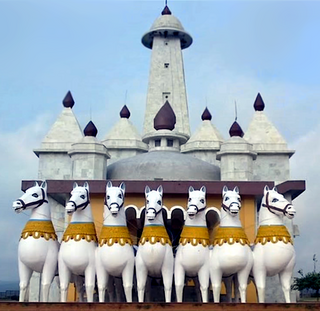
The Surya Temple or Surya Mandir, located near Bundu, is a Hindu temple complex dedicated to the solar deity, Surya.

Umga Sun Temple also known as a Umga Surya Mandir is a Hindu temple in Madanpur, Aurangabad, Bihar. The temple is a Sun shrine, dedicated to Lord Sun for Chhath Puja. The temple is located in Madanpur, Aurangabad in the Indian State of Bihar. Umga Sun Temple is situated on Umga hills, Umga hills famous as a tourist place in Aurangabad Bihar. According to religious belief, After Deo Sun Temple, Umga temple is second in important temples for Chhath Puja.
